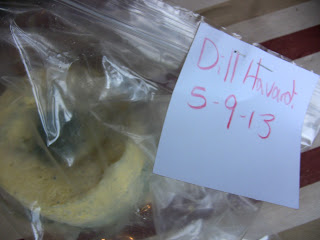Anyhow. In May I made several different cheese and tried out a new storage system; each cheese got put in a plastic bag labeled with the type of cheese and date of manufacture. This helps in knowing when to eat the cheese. When I took out the cheeses (pics taken July 10th) there were different amounts of mold on each cheese due to type and pre-storage treatment of the cheese. I will go into pre-storage treatments in part 2- this post is going to focus on cleaning mold off.
I think most amateur cheesemakers will have mold, and it's not the end of the world. What follows are the winners and losers in my mold contest.
 |
| Winner: Salt-cured Derby |
 |
| Loser: Cheshire |
For this cheese, as well as the three others that had mold growth, I simply ran it under cold water and wiped most of the mold off. Afterward I went through with a scrub brush (bristles were rather soft) and brushed whatever mold I could out of the cracks. This is what the Cheshire looked like after a washing.
Honestly, it still looks pretty bad. I will probably let it air out for a day or two, cover it in salt for another day or two to dry it out, and then coat it with oil and wrap in cheesecloth as more precaution.
The other cheeses cleaned up nicely, though.
 |
| Dill Havardi, in storage 31 days. |
 |
| Havardi, in storage 33 days. |
 |
| Swiss, in storage 22 days. |
Not bad at all. There was still some mold, but nothing that can't be cut away when the cheese is ready to be eaten. I was really happy with the way these turned out.
Stay tuned for part 2, for discussion and speculation on the whys and wherefores of mold growth and pre-storage treatments.


No comments:
Post a Comment